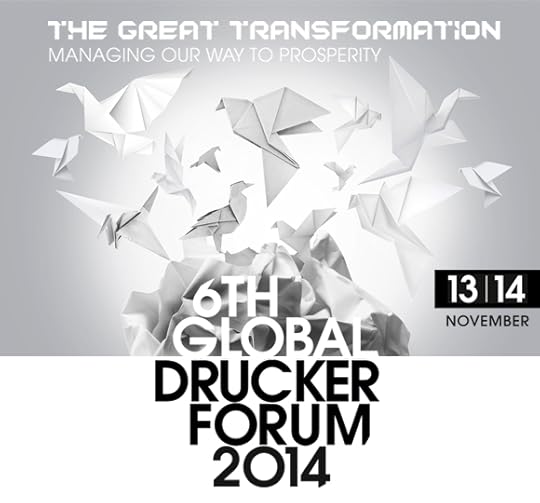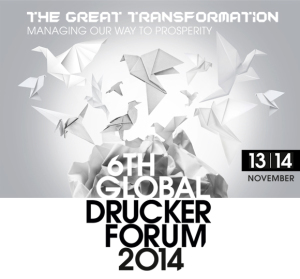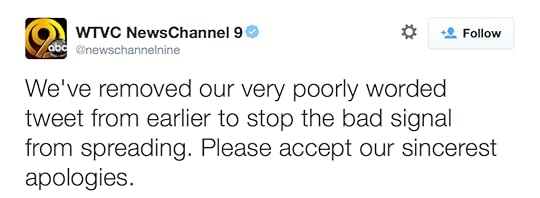Dan Pontefract's Blog, page 37
January 5, 2015
Conation: The Word of 2015
How words lose their luster boggles the mind.
At least it boggles my mind.
 Conation is one of those words and it just so happens to be my Word of 2015.
Conation is one of those words and it just so happens to be my Word of 2015.
Back in the 18th century, German academics began classifying the ‘self’ — to be specific, the ‘mind’ — into what is known as the tripartite classification of mental activities.
Ok maybe now we know why some words lose their luster.
In the 19th century, American and British psychologists took the classification and began utilizing it in their own research, as well as with their patient work. They improved the original work and further honed the tripartite.
The three bits to the classification include cognition, affection, and conation. (Editor’s Note: even as I type conation, swirly red lines can be found underneath the word be it on a Mac or a PC, so even the ‘machine’ has no idea what it means.)
Cognition, as you know, deals with the “what“. It’s when we interpret, process and understand the gazillion number of data points and information strands that enter our mind each day.
Affection is more about the “how“. Think of it as whether you like someone (or something) or perhaps you don’t. Affection is whether you are attached to an idea, issue, person … or you’re not. (E.g. I possess a love affection for Denise)
But conation … the alleged ugly stepchild to the tripartite (it a candidate for Word of the Year in 2016) is arguably a word Simon Sinek might enjoy. It’s about the “why“. Conation comes from the Latin ‘conatus‘ or ‘conationem‘ and is defined as “any natural tendency, impulse, or directed effort.”
These days Oxford Dictionary defines conation as:
“the mental faculty of purpose, desire, or will to perform an action; volition.”
At its core, conation is rather brilliant. It has the capability of taking the knowledge, data and ideas you interpret and process (cognition) and blend it with your emotions, likes and dislikes (affection) into behaviour, purpose and action. In my mind, conation is the missing link in today’s organization as we seek a better balance with power, profit and purpose.
Conation is an aspect of human behavior that motivates leaders to independently seek out and create a better society.
 The societal data is everywhere. (what and cognition)
The societal data is everywhere. (what and cognition)
I believe the will of the human spirit to do ‘good’ remains pervasive. (how and affection)
What’s missing? If our organizations — and leadership in general — is to shift away from a fixation on profit and power while improving society, employee engagement and our communities, perhaps it’s conation that’s now required. (why and action)
Some argue that conation “has been a neglected dimension of behavior in neuropsychological assessment” and that it just may be “the missing link between cognitive ability and prediction of performance capabilities in everyday life.”
I believe it’s one of the missing elements of leadership, and thus the true definition of purpose in the organization. It is through this dogged action — volition, perhaps — where we might once and for all improve work, life and society together.
Conation is my word of the year for 2015.
It’s time for us all to become conative.
Man never made any material as resilient as the human spirit. Bernard Williams
Dan's Related Posts:Can Humanism Replace Capitalism?My Hopes for the Drucker Forum #gpdf14In 2015, Will I …Alarming Trends in CIPD Employee Outlook SurveyCommunitas: The Word of 2014
December 31, 2014
In 2015, Will I …
Publish the next book ?
Grow as a father to ‘let some things go‘?
Become less intense?
(finally) Run >10km in one go again?
Cycle >5000km?
Celebrate 20 years of marriage (on July 1) in style?
Overachieve on the expectations of TELUS Transformation Office?
Receive >50,000 views at Forbes ?
Write >50 ‘thought leadership’ pieces for various outlets?
Stop using the term ‘thought leadership‘?
Visit three major cities I’ve never been to before?
Spend more than three weeks in Ontario? (on purpose)
Decide (with Denise ) a proper 10-year plan?
Be asked to speak at >20 events?
“Live well, love always and laugh out loud every day” (© Brian Reid)
Dan's Related Posts:In 2014, I Will …Whose Your Brian Reid?Who Am I? Who I Am.Lessons Learned From a First Time AuthorWe May Not Always
December 12, 2014
We May Not Always
We may no t always be near one another, but I think about you often.
t always be near one another, but I think about you often.
We may not always agree, but I always respect your opinion.
We may not always want the same things, but I love your creativity.
We may not always be equal, but I look up to you in awe.
We may not always enjoy one another, but cooler heads usually prevail.
We may not always be responsive, but guilt has its way of ensuring the line reconnects.
We may not always adjust for speed bumps, but dreams don’t come to fruition smoothly.
We may not always say please or thank you, but my reverence for you is boundless.
We may not always plan ahead, but trust tends to bide us some time.
We may not always hug it out, but in my heart I know we both deeply care.
We may not always light a fire, but sparks seemingly fly no matter the scenario.
We may not always reciprocate, but no one is keeping score.
We may not always laugh, but appreciation doesn’t always need to be heard.
We may not always love, but hate is never an option.
We may not always … but as you know, always, we just may.
Dan's Related Posts:The Simple Act of TrustingWho Am I? Who I Am.Instead of Inbox Zero, How About Outbox ZeroGoing Forward to the Past: Management Yahooliganism & No Longer Working From HomeIF
November 28, 2014
What Should The Title Of My Next Book Be?
 It hasn’t been through any editing yet.
It hasn’t been through any editing yet.
It’s 12 chapters in total.
It’s approaching 90,000 words. (again)
There are two sections.
The first section has the following draft chapter titles:
Chapter 1 – The Possibility of Purpose at Work
Chapter 2 – What is Work?
Chapter 3 – The Pursuit of Workplace Disengagement
Chapter 4 – We Built This City (of Consumerism)
Chapter 5 – Power Plays in the Organization
Chapter 6 – Money, Budgets, Greed and Maximizing Shareholder Value
The second section has the following draft chapter titles:
Chapter 7 – The Purpose of an Organization
Chapter 8 – Job. Career. Purpose.
Chapter 9 – Develop. Define. Decide.
Chapter 10 – Organizational Communitas
Chapter 11 – Management Muscles
Chapter 12 – Now. Near. Nexus.
Any thoughts on an appropriate title at this point, despite not having any further information to go on?
Or, how about commenting on the draft title I came up with:
WORKING CLASS: The Leaders Path to Profit with Purpose
Thanks in advance for your feedback.
Dan's Related Posts:Download Chapter 1 for Free – Flat Army: Creating a Connected and Engaged…Flat Army: Chapter 5 OverviewFlat Army: Chapter 6 OverviewFlat Army: Chapter 1 OverviewFlat Army: Chapter 11 Overview
November 24, 2014
How Not to Tweet if You’re a Television Station
Like thousands of other webizens, I took to Twitter on the evening of November 24, 2014.
I did so to understand how Ferguson, Missouri was handling a grand jury’s decision not to indict Officer Darren Brown, the man behind the gun that killed Michael Brown on August 9, 2014.
Mike Costa is the General Manager of “Chattanooga’s Number One TV Station” and — or so it seems — the brains and brawn behind its Twitter account.
Things began going south rather quickly with Mr. Costa when — as his main network cut into his station’s normal programming — he decided to tweet the following:
On one hand, perhaps Mike thought he was providing a good deed to the 28,000 Twitter followers of WTVC NewsChannel 9.
On the other hand, it’s a rather good argument of depicting everything that is wrong with society today. It’s not only insensitive, it’s inane.
I mean, “Dancing with the Stars?”
Really?
And you had to use the #Ferguson hashtag, right?
Things got progressively worse. It was as if Mr. Costa was Bambi and Twitter was Godzilla … not dissimilar to that 1969 classic movie, Bambi Meets Godzilla.
Spoiler alert: it didn’t end well for Bambi.
Mike decided to take down the ill-advised original tweet, and then proceeded to tell everyone about it.
Alright Mike, apology accepted (well done, actually) … but did you have to tweet, “to stop the bad signal from spreading?” This isn’t H1N1 or the Measles. It’s just a tweet. A bad tweet, but just a tweet.
Next up, Mike decided to start engaging people. One of the best was his exchange with @lovesickglee, where he pleads his innocence. Sure, you may have had some unruly customers and were trying to be proactive, but rule number one when it comes to anything on social media is to “think before you type”. (In all fairness, Mike did use the word “lunkheaded” in this tweet, so I forgave him for a nanosecond.)
When Twitter user Michael Killi issued a somewhat innocuous tweet suggesting the night was going to be long for “the person running the @newschannelnine Twitter account” what did Mike do?
You may not believe this, but Mike decided to retweet Michael’s tweet. #OMG
And finally, Mike Costa ventured over to his own Twitter account, and once again, issued another apology.
I believe him on this one as well.
But like I stated earlier, “think before you type”.
Insensative? Poorly word? (as opposed to insensitive and poorly worded)
I’m certain Mr. Costa is the General Manager of a television station. His Twitter profile says so. I reckon it was a tough night for him.
But Mike, in situations like this, it’s best to apologize once and step away from the Twitter.
Afterward, for what might be an incomprehensible number of apologies coming out of one man’s laptop, naturally, Mike apologized for his spelling mistake.
But he missed the correction to “poorly worded”.
“Think before your type!”
Godzilla 1. Bambi 0.
Dan's Related Posts:A Twitter Conversation With Myself About Culture and CetaceansVideo Review of Drucker Forum 2013Lessons in Leadership From Jim Balsillie and Mike LazaridisTweet Kings & Pretty Things (aka Micro-Blogging Habits)Don’t Simply Follow on Twitter, You Should Spend Time Reviewing
November 18, 2014
The Great Transformation of the Organization Still Needs the How
 Billed as “The Great Transformation”, its work was cut out for itself from the moment you could register online. A conference paying homage to the brilliance of Peter Drucker has now become an annual calendar fixture not to be missed. The 6th iteration of the Global Peter Drucker Forum — recently held in Vienna, naturally — has arguably become the TED or Davos of all leadership conferences. But could we shift into an era of “managing our way to prosperity,” as the conference sub-title suggested?
Billed as “The Great Transformation”, its work was cut out for itself from the moment you could register online. A conference paying homage to the brilliance of Peter Drucker has now become an annual calendar fixture not to be missed. The 6th iteration of the Global Peter Drucker Forum — recently held in Vienna, naturally — has arguably become the TED or Davos of all leadership conferences. But could we shift into an era of “managing our way to prosperity,” as the conference sub-title suggested?
Could we achieve “The Great Transformation”?
Richard Straub, the Forum’s chief architect, asked a rhetorical question in his opening remarks to the Forum, “Have we reached a turning point?” The ‘we’ he referred to might have been leaders in today’s organizations. I reckon you could argue it was ‘society’ in general that needed an autopsy on turning points. Either way, I sat at my seat, took another look at magnificent mural on the ceiling, and answered the question Richard posed to myself.
No.
We haven’t reached a turning point.
At least not yet.
We’ve reached a crisis point.
Think of it as if you were a member of the G7, trying to sort out what to do about Russia, Vladimir Putin and the ongoing saga that is the Ukraine.
Richard went on to suggest Peter Drucker himself would have categorically stated that, “Management has a key role to play in this transformation.” Hard to disagree with Richard on that point, however, data suggests management remains ambivalent if not clueless to key transformative opportunities. Concepts such as maximizing shareholder value as the singular measure of success, bureaucracy and command and control tactics as the basis for organizational culture and leadership, amongst various human resources inanities that make it difficult to ever feel engaged at work are as prevalent today as traffic congestion on Silicon Valley’s Highway 101 will be decades from now.
Management is the problem. The crisis, ergo, is management.
If we are to reach a transformative “turning point” there would have been many more participants than the 2500 combined in-person and online attendees taking part in this year’s conference. This is not to take anything away from Richard or conference attendees — for these folks are the true trailblazers of organizational change — but if we are to see a great transformation in our lifetime, the Global Peter Drucker Forum ought to become the vehicle for the turning point itself. And we need more people involved to achieve that type of mission.
Quite frankly, the conference should have attracted more than a football stadium full of leaders who want to see such a transformation. “I wish us all an inspiring conference,” Richard gleefully uttered as he concluded his opening remarks. Indeed, it was an inspiring conference … but by the end of the two days it became a stark reminder of how far society needs to venture if we are to truly aspire to a “great transformation.”
Adi Ignateus, Editor-in-Chief of Harvard Business Review, stepped to the microphone looking joyful if not hopeful and bellowed,
“Our starting point is that things are not ok. Debt levels are high, respect for institutions is low, equality is suspect, and we can’t beat the stranglehold of short-term thinking.”
I wanted to give him an affectionate, Canadian polar bear hug — mostly because I’ve been banging on my drum about his opening statement for years — but I ran out of time because walking up on stage to deliver their opening morning keynotes were Pele, Maradona and Sir Bobby Charlton.
No, not really.
But would you believe the opening act included Clay Christensen, Gary Hamel and Roger Martin? This conference was about to get epic. What a triple-play bill of thought leaders to begin with.
The question this trio was tasked to answer was, “Is management up to today’s challenge?”
Renown Harvard Business School professor, Clay Christensen, — he of the disruption theory and accompanying models — claimed that growth comes from innovation and the link between growth and innovation is investment. Clay suggested there are three types of innovation:
Market creating innovations (only the rich have access to it) e.g. the computer. It’s the source of all corporate and national growth. The kind of innovations that allow access to more people and services.
Sustaining innovations – most of what we see today are sustaining innovations, he said. It helps an organization’s margins improve because they make markets vibrant. They don’t create growth, per se. These innovations are important but they are replicative.
Efficiency innovations – helps an organization get lean. If the firm doesn’t get more efficient, they get kicked out of the game sooner. It’s when an organization seeks to “do more with less” as an innovation strategy.
When I heard Clay gracefully and calmly explain the “efficiency innovation” example — using the term “do more with less” — I immediately felt my body go into uncontrollable spasms, reminded of the far-too-frequent number of times I’ve heard that soul-sucking phrase in my various workplace dealings. I always thought it was a practical joke of CFO’s to wax lyrical about doing more with less.
Where I felt Clay answered the question most effectively, however, was when he launched into a finance lesson on numerators and denominators. “Prior to 1980, measures of success were based on whole numbers,” he remarked. “For example, dollars were used as the measurement.” Now that made sense. But Clay went on to outline something I hadn’t thought of before.
“Finance has now given us measures to view how successful we are with capital. These are measures of how efficiently we are using capital. They are ratios and as we know, ratios have a numerator and a denominator.”
Although Clay didn’t come right out and say leaders need to revert back to reporting on and setting whole numbers as financial targets, he did crystalize the fact that there are now two levers to tweak so an organization can improve growth. Actually, it’s been going on for well over 30 years. This, in part, provided me with an answer to the question, “why have our organizations stagnated?”
If an organization wants to become more innovative, what they’re really playing around with isn’t innovation itself, but ratios of capital. This can’t be good. If an organization truly wanted to be innovative, it would invest in the numerator but if that proved too hard — if IRR (internal rates of return) were too low or too slow to achieve — the Finance and/or C-Suite could simply reduce the denominator on the capital ratio.
It’s obvious to me far too many firms are taking the easy way out and shirking their innovation responsibilities by nudging the denominator versus the numerator. Clay said as much by claiming capital has now become abundant and cheap, yet organizations husband it. He believes we’re going in the wrong direction and I couldn’t agree more. Innovation and thus investment in the numerator is required. We need to refrain from the fixation on share buybacks, and use the capital (i.e. the profit) to invest back in the numerator.
Great strategy from Clay, arguably the world’s smartest thinker according to Thinkers 50.
“We stand on the shoulders of others,” exclaimed another management guru Gary Hamel, as he took the stage in what can only be described as a frenetic delivery style, compared to Christensen at least. With the audience half-scared he might venture off the stage to deliver head-butts, he continued,
“How can we build organizations that are adaptable at its core?”
Gary answered his own question right out of the blocks. “Organizations aren’t up to the challenge,” he yelled. (Seriously, he yelled.)
I was scared.
“If the organization wants to survive, they have to transform themselves,” he continued. Ok, I’m with you Gary … but what’s your strategy for change?
He attempted to answer the rhetorical question I asked myself. Gary believes salvation and prosperity (there’s that word again) can be had if the goal of organizations becomes the process in which they can become a self-renewing organization. This happens by innovation which, as he stated, “is the fuel for renewal.” He outlined three approaches (they were questions in all honesty) to build a self-renewing organization:
How have employees been trained as a business investor?
If an employee has an idea, how can they get capital to launch it?
Is the organization measuring the investment/idea and attaching it back to compensation and other targets?
It’s hard to argue with Gary’s ideas, but three things donned on me when he concluded.
First, he’s loud.
Second, the culture within many organizations is far too closed and hierarchical as it stands today, therefore the steps outlined above will never occur unless it’s fixed.
Third, as Christensen pointed out, it’s far too easy for an organization to impose a “do more with less” mantra and to then fiddle with the denominator than it is to make innovation investments with the numerator. So in reality, this has to be fixed first — alongside the culture of an organization — before we can achieve the status of a self-renewing organization that he purports.
Gary is an enthusiastic speaker, replete with plenty of Tweetable catch-phrases — e.g. Management is the love child of Julius Caesar and Frederic Winslow Taylor by introducing command and control tactics and industrial engineering to organizations — but I’m not entirely convinced he effectively answered the question, “Is management up to today’s challenge?”
The final opening act soccer star (err, speaker) was fellow Canadian, Roger L. Martin, Academic Director of the Martin Prosperity (there’s that word again) Institute out of the Rotman School of Business in Toronto. Truth be told, I’ve always been a fan of Roger’s work. He long has railed against the “game” that has been played by publicly traded companies, analysts, hedge funds, pension corporations and the stock market. He, like me, yearns to bring balance to our organizations such that there may be a better sense of equilibrium between purpose and profit.
His talk, as I had hoped, delivered on multiple levels. Speaking on the “Structure of Democratic Capitalist Infrastructure” and how it has become what he calls “perverted”, Roger explained to a captivated audience that “patent trolls” exist solely to make money and they do so by raping and pillaging companies that want to use the technology for good. You should tweet that sentence.
With this inexcusable mindset in play, the infrastructure inside our organizations is set to be far too narrow, thus basing its interests on short termism type actions. As I am an opponent of maximizing shareholder value as the sole means to measure a business, Roger deftly argued (and phew, agrees with me) that this sort of deplorable corporate robbing creates stagnation, a lack of innovation, and a skewing of what the true purpose of an organization really should be.
It was fun to watch Clay Christensen walk off of the stage where he was seated so he could have a better view of Roger’s graphs and charts, which spoke volumes to Roger’s overarching thesis.
Notable comments from Roger throughout the conference included how:
“we’ve structured the corporate world in a way that facilitates the operation of bandits,”
and
“the highest rewards in today’s economy go to people who trade value, and not to the people who create value.”
As usual, Roger nailed it. (#mancrush)
The Global Peter Drucker Forum was two hours into its journey but, with a tear in my eye, I was becoming more depressed by the second. The talks to this point were splendid but the recipe for change — the master playbook for “The Great Transformation” — seemed complex and beyond our reach. Were my expectations off kilter? Or, perhaps, I was correct in asserting we were not at a turning point, but at a continued state of crisis.
The speakers continued throughout day one. Each took a turn identifying the problem, and for some, taking a crack at a solution.
Rick Goings, CEO of Tupperware, told us that:
“leaders are about the sustainability of the organization and that innovation is one of the tools at their disposal.”
More importantly, he felt leadership “is not just to build companies, but to create opportunities for all.” Alright, no disagreement from me on that point, but where’s the how?
Nancy Tennant, Vice-President of Innovation at Whirlpool Corporation suggested for an organization to become innovative — like what they allegedly accomplished at Whirlpool — they should define what innovation is to the firm, train employees on that definition, and then watch how innovation will become an operating norm. Ok, I’ll buy that.
Vineet Nayer, the former CEO of HCL — a company and leader I profiled in FLAT ARMY — stated the turnaround at HCL was due, in part, to a democratization of innovation where ideas were allowed to surface from anywhere, and decisions were made across any level.” He believed that an organization’s competitive advantage lies in “putting employees first, and customers second.” I’ve read the book, so if you’re looking for the ‘how’, there are some good examples you might want to investigate.
Would an economist have better luck answering our question? Martin Wolf, Associate Editor and Chief Economics Commentator at the Financial Times, gave it his best shot suggesting no one individual should be allowed to own a company. “No one can own a country,” Wolf further stated, “so the claim that shareholders should have absolute control of the company is false.” I liked where he was going. It reminded me of the work another economist — Bill Lazonick — had put forward recently on Harvard Business Review.
The real answer began to surface from him when he said, “If management is to use its position to benefit the company and society, it needs the best arrangement in which to do so.” His answer?
“The company should be seen as a semi-permanent institution and philosophically it should be set up much like a trustee relationship.”
Bingo! Wolf had set the table (it felt like a feast) and highlighted a possible answer to our vexing question. Perhaps Wolf was suggesting companies re-establish themselves as B-Corps, (I wrote about B-Corps on Huffington Post) otherwise known as Benefits Corporations? I’d be all for that idea.
Pankaj Ghemawat, a professor at NYU laid part of the blame on today’s business schools. He said, “Irrespective, there is an error of omission in business school education today without being exposed to market failures.” So, in part, an answer can come from the redevelopment of business school education such that market failures are addressed. I’ll agree to that, however, business schools need to take a long, hard look at what they’re teaching and (perhaps) think about a more balanced view of purpose with profit. (I have more to say on this when we make a spectacular announcement in January)
In his usual thoughtful and cerebrally controversial way, John Hagel — Co-Chair of the Deloitte Center for the Edge — claimed most companies are an unnatural bundle of three business types:
Infrastructure management business – high volume e.g. call center
Product innovation and commercialized – e.g. iPad
Customer relationship business – knowing customers better, and helping them more
He reminded us that Peter Drucker once wrote that the role of a CEO is to answer the questions, “what is our business, what should be our business, and what shouldn’t it be.” Hagel wondered aloud if the organization is to keep all three types of business types alive, the end game of the firm will undoubtedly be compromised.
Notably, John indicated between 1965 and present day, ROA (return on assets) has collapsed by 79%, attributing the decrease to a fixation on non-scalable institutions (i.e. the fixation on all three types of business models he defined) as opposed to implementing his answer, the scalable learning organization.
By the end of Day One, it was clear to me many smart people have thought an awful lot about the current crisis. Each had provided a wonderful snapshot explaining “what” was wrong but I still was missing the unified “how is this going to get fixed” answer.
Was there a unified answer out there?
Day two, thankfully, saw the inclusion of several more women delivering talks and panel discussions. Day one was heavily skewed toward the male gender. There were three talks in particular that I found further defined our current crisis, that also provided a glimpse into how our organizations might be fixed.
Rita Gunther McGrath, a professor at Columbia Business School, delivered a delightful talk suggesting “intelligent failures” need to become more common in today’s organizations. “You had a plan, you tested it, you knew what went wrong, you shared messages of failure, you learned from it, and you innovated again,” was how Rita explained the concept. My take from Rita’s talk was organizations need to be resilient and flexible — while not only being a learning organization — agreeing to gather and disseminate the tuition value from mistakes.
Nilofer Merchant, entrepreneur extraordinaire, took the conch and wonderfully hammered home the point that social is not a technology, it is a behaviour. (She actually stopped her talk mid-keynote and asked us to get social with someone beside us) Her point? The more people are allowed (and encouraged) to connect and collaborate, the greater payoff your organization will have downstream. I loved Nilofer’s message in addition to her delivery style, something I hadn’t yet experienced face-to-face. (If you haven’t watched her TED Talk, please do so. It’s a gem.)
Herminia Ibarra, a professor from Insead, gave incredible insight into the nuances of different types of leaders. From heroic, to charismatic, to visible, to individualistic, to peacetime/wartime, to collaborative, Herminia’s examples were insightful, funny and painful for their accuracy. I’ve always appreciated her work and the connections she makes between effective (and ineffective) leadership and the crisis we find ourselves in today’s organizations.

Photo Credit: Kenneth Mikkelsen (@LeadershipABC)
In the lead up to this year’s conference, I was asked by Steve Denning, author of Radical Management and one of the coolest provocateurs out there, if I wanted to a) speak at the conference as part of the track he was chairing and b) if I would work with him on a position paper outlining the hopes and dreams for the Drucker Forum itself.
I delivered a talk on day two, focusing my message on three key parts.
First, there is causality between an engaged organization and much improved business metrics.
Second, FLAT ARMY is a “how to” manual for organizations to achieve the open operating culture that can mitigate the issues found in today’s organizations.
And third, I used the platform to explain how a corporate culture change at TELUS (my place of work since 2008) helped to increase employee engagement from 53% to 83% while improving countless business metrics in parallel.
The bottom line? If you create an inspired, empowered, authentic and collaborative organization, an innovative, customers first output will be the result. This leads to what so many organizations yearn for … improved business AND non-business results.
The paper we worked on (with Bill Fisher, Haydn Christensen and Nick Dixson) was posted to Forbes before the conference began, and in it, we posed three questions:
Should firms make the shift from the goal of maximizing shareholder value as measured by the current stock price to a principal focus on adding value to those for whom the work is being done?
Should organizations make the shift from the practices of hierarchical bureaucracy to the collaborative leadership and management practices of the Creative Economy?
Should organizations make a shift from metrics that reflect narrow financial goals to metrics that reflect contributions to prosperity of individuals, organizations and society, for achieving both purpose and profit?
Whilst the aforementioned questions were not answered at the Drucker Forum outright, I left thinking I wasn’t alone.
From the various speakers, to the attendees I spoke with, to several meaningful and deep conversations, — it’s evident everyone is (for the most part) on the same page.
We may not be at a turning point but we’re all acutely aware of the crisis we’ve gotten ourselves into.
The questions found above were met with unanimous agreement from a Drucker Forum choir of voices that sang, “but of course, we need to change” in collective harmony. Given we were in Vienna, it was fitting. We left the conference with an agreement on the ‘what’. Phew. Now we need action on the ‘how’. And we need it ASAP.
As Clay Christensen remarked in the closing comments to the conference,
“Let’s take the best of each other’s ideas and languages, — our ways of communicating — share, focus and then standardize to make change.”
Hallelujah. That sounded like a mission to prosperity indeed. (There’s that word again, only this time there were violas playing.)
Note: originally published at Huffington Post
Dan's Related Posts:My Hopes for the Drucker Forum #gpdf14The TED of all Leadership Management Conferences – A Review of the Drucker Forum…How B Corps Just Might Eliminate the Foolishness of Maximizing Shareholder ReturnSteve Denning Nails It on Forbes: Paradigm Shift in Leadership and ManagementRethinking the Work of Leadership
November 12, 2014
My Hopes for the Drucker Forum #gpdf14
It’s not exactly the easiest set of flights between Victoria, British Columbia and Vienna, Austria, but I’d travel twice the distance to take part.
 The Global Peter Drucker Forum is one of those rare conferences where one believes change might actually occur. That’s why I’m here. That’s why I’m up at 4:30am Vienna time, writing these words.
The Global Peter Drucker Forum is one of those rare conferences where one believes change might actually occur. That’s why I’m here. That’s why I’m up at 4:30am Vienna time, writing these words.
The sub-plot to this year’s conference is “The Great Transformation: Managing our Way to Prosperity”. It couldn’t be more blunt. It couldn’t be more timely.
Our organizations – for-profit, not-for-profit or government – are in dire need of a transformation. One might argue the opportunity is ‘great’. One might also argue we need a clear path toward a different kind of prosperity, one I like to refer to as “purpose with profit“.
In the lead up to this year’s conference, I was asked by Steve Denning (I know, Steve Denning!) if I wanted to a) speak at the conference and b) work with him on a position paper outlining our hopes and dreams for the Drucker Forum itself.
He had me at ‘hello’ regarding the speaking opportunity (with all-star thinkers Haydn Shaughnessy and Bill Fischer) and the paper was posted to Forbes.
In the paper, we pose three questions:
Should firms make the shift from the goal of maximizing shareholder value as measured by the current stock price to a principal focus on adding value to those for whom the work is being done?
Should organizations make the shift from the practices of hierarchical bureaucracy to the collaborative leadership and management practices of the Creative Economy?
Should organizations make a shift from metrics that reflect narrow financial goals to metrics that reflect contributions to prosperity of individuals, organizations and society, for achieving both purpose and profit?
Maybe it’s the jet lag and the fact it’s still Wednesday where I come from (as opposed to Thursday morning as I’m typing) but in all honesty, I not only want those questions answered from above, I’d like to see action taken.
Since the early 1970’s, we have witnessed not only the fundamental collapse in the principles of an organization (from an equilibrium with stakeholders to a myopic fixation on shareholders) we have instituted leadership & management practices that define ‘shock and horror’ if not ‘shock and awe’.
We should not be proud.
In fact, we ought to be frightened.
I am the proud father of three young goats (Claire is 11, Cole is 9 and Cate is 7) and if I ask for anything from the Drucker Forum 2014 — if there is an altruistic hope I yearn for — it is to create the conditions that bring balance back to our organizations. This is “the great transformation” required today. I do not want to saddle my children with what has become a societal norm in today’s organization. That norm that oozes out of any sort of organization is hierarchical, closed, fanatical for profit, and disdain if not ignorance for the future of humanity.
When the C-Suite begins to look at employees not as costs — not as headcount — but as investments in the firm’s future success, that is the precise moment when we have achieved a return to organizational equilibrium.
When the Board of Directors stamps their hands on the boardroom table demanding a return to the equal balance of interests that concerns all stakeholders — community, employees, customers and shareholders — only then do we have a true path to prosperity.
It was none other than Peter Drucker who once wrote, “To know what a business is, we have to start with its purpose. Its purpose must be outside of the business itself. In fact, it must lie in society since business enterprise is an organ of society. There is only one valid definition of a business purpose: to create a customer.” (The Practice of Management. Peter Drucker. 1954. HarperCollins)
Fellow Canadian and Drucker Forum speaker Roger Martin wrote in his book Fixing the Game, “We must shift the focus of companies back to the customer and away from shareholder value. Companies should place customers at the center of the firm and focus on delighting them, while earning an acceptable return for shareholders.” (Fixing the Game: Bubbles, Crashes, and What Capitalism Can Learn from the NFL. Roger Martin. 2011. Harvard Business Review Press.)
I am wrapping up my next book and I thought it would be fitting to include my definition of the purpose of an organization. At the risk of attempting to outdo several literary and leadership giants, might I suggest the following:
“An organization’s ideal is to delight its customers through an engaged and purpose-focused workforce, acting ethically within society while delivering just profitability. ”
I’m delighted and proud to be at the Drucker Forum 2014.
I’d be even more delighted and proud if this conference were to be the lightning rod for actual, meaningful change.
Dan's Related Posts:Video Review of Drucker Forum 2013The TED of all Leadership Management Conferences – A Review of the Drucker Forum…How B Corps Just Might Eliminate the Foolishness of Maximizing Shareholder ReturnDrucker Forum – Video Update #1 – Conference OverviewIn 2014, I Will …
November 3, 2014
Alarming Trends in CIPD Employee Outlook Survey
Truth be told, I’m a bit of a research wonk. Some may look at that honest admission as a cry for help. Others steer clear of me when I ingest new data because it allegedly makes me more likely to furl a brow as I further scorn the lack of leadership advancement in today’s organizations. This ‘feedback’ may or may not come from my beloved wife.
Nonetheless, we move on.
Twice a year, I look forward to the release of the CIPD Employee Outlook survey, sponsored in part by Halogen Software, one of the Canadian-based companies I’ve been watching for a while.
 CIPD identifies itself as follows:
CIPD identifies itself as follows:
A professional body for HR and people development. It has over 130,000 members internationally working in HR, learning and development, people management and consulting across private businesses and organisations in the public and voluntary sectors. As an independent and not for profit organisation, the CIPD is committed to championing better work and working lives for the benefit of individuals, business, the economy and wider society – because good work and all it entails is good for business and society at large, and what is good for business should also be good for people’s working lives.
The survey is important because it provides insight into several facets of career and talent development as well as employee engagement. The latest version is no different.
The highlights for me in this edition include:
33% of employees indicate that their careers have failed to live up to their aspirations
12% of respondents indicated their career has actually exceeded their expectations
37% state that their career aspirations are unlikely to be met by their current employer
Employee engagement has risen from 35% to 38%
Net job satisfaction scores have risen two points to 44%
Job satisfaction was the most important factor identified in contributing to satisfaction with career or working life (72%).
Work–life balance was the second most important factor (66%).
59% agree or strongly agree they have a proper work-life balance
39% of employees report that they experience excessive pressure every day or once or twice a week
What does this mean?
Quite simply, there is still much work to be done in today’s organizations when it comes to employee engagement, career and talent development and culture. What is being introduced by leaders to deliver on the requirements for organizational culture change is not enough.
As leaders, we cannot be pleased with an increase in employee engagement from 35% to 38%. There is no cause for celebration at such anemically low levels as reported by CIPD.
As leaders, we cannot be pleased that one-third of employees think their careers have not — nor will ever reach — a self-identified level of expectation that is appropriate. (we might even toss in the word, “thriving”)
As leaders, we cannot lose sight that there is a causal relationship between an engaged employee who performs ‘the work’ (who is completely satisfied in their role) and various improved business metrics as a result of such harmony in the workplace. When he or she is able to occupy a proper work-life balance while feeling devoid of excessive and unnecessary workplace pressure, amazing, innovative outcomes manifest.
Reading the data from CIPD (once again) indicates to me the transformation of our organizations is only in its nascent stage. I’m not sure it’s even started in certain organizations.
Leaders … we cannot be pleased.
Dan's Related Posts:Whose Job Is Leadership, Anyway?Try Implementing Flexible Work Options to Increase Employee EngagementMy Next Role Is …My Definition of Work and an Update on Book TwoFlexible Working Works
October 23, 2014
When Euan and Dan Keynote Together at #HRtecheurope
The very talented Frédéric Williquet sketched both my keynote and good friend Euan Semple’s from our time at HR Tech Europe … and the result is fabulous.
Thanks Frédéric.
Dan's Related Posts:Flat Army CSTD Keynote as ArtFavourite Posts and Articles of 2013 That I ReadInternet Activities Do NOT Affect Adolescence DevelopmentThe TED of all Learning Conferences #LWF12Goodbye Team of Five Years
October 22, 2014
O Canada My Canada
The wind blew my kind ashore, but the native maples were here long before.
We are the settlers of settlements, the villagers of villages.
That is what we are.
Canada … a village of settlements; a nation.
Lower and Upper.
West and East.
North and South.
French and English.
Indigenous and immigrant.
Don’t be mistaken, for we do not settle.
We do not bend.
Our land is glorious and free.
You cannot scare away the villagers from our home and native land.
We will never settle.
We will never bend.
These villagers are bred and bleed to stand on guard for thee.
To you from failing hands we will burn the torch brighter.
For we are the villagers and the settlers of the villages and the settlements of this great land called Canada.
True patriot love.

Dan's Related Posts:Kudos Jacques Godin, an Engaged Air Canada EmployeeAir Canada Isn’t Collaborating With Its EmployeesAn Infographic Depicting Learning & Collaboration in ActionWe Are All BostonCan Employee Engagement Improve Customer Satisfaction?












